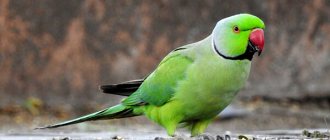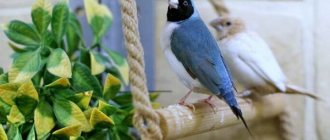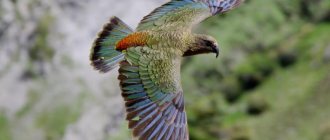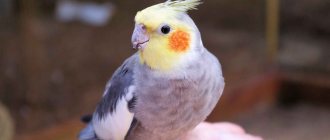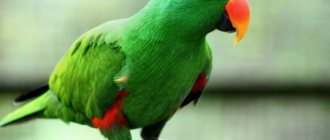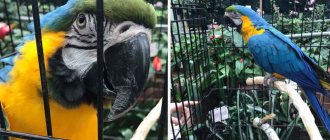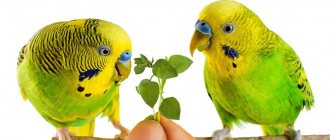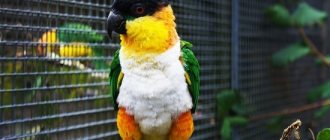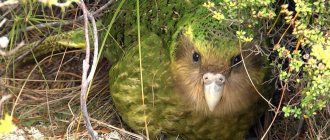Kea parrots are fairly large birds, about the size of a crow, with a powerful beak strongly curved downwards. They live on the South Island of New Zealand and live mainly in the highlands in a harsh climate with fog, winds and snowy winters.
The main color of the kea's plumage is green in different shades, but due to the purple tint it appears dark from afar. The wings below are fiery orange, and when the parrot spreads them or takes off, it looks like a phoenix engulfed in flames!
Kea parrots are perhaps one of the most amazing birds on the planet. Unbridled, noisy, mischievous, and at the same time very smart - this is how these birds can be characterized. They are known to tourists for their cheerful and hooligan disposition, but local residents have a very ambiguous attitude towards them. Many New Zealanders consider kea their number one public enemy. And all because the birds are addicted to pet lard, which is very expensive for New Zealanders. It turns out that kea parrots' passion is sheep's fat...
Of the rather large order of parrots (Psittaciformes), which includes 324 species of birds, only one species from the genus Nestor, namely the kea parrot (N.notabilis), is addicted to animal food - lamb. You say that a parrot is a predator, this is absurd. After all, all parrots are herbivorous birds that adore the juicy fruits of tropical fruit trees, nuts, seeds and grains of cereals. Sometimes, of course, they diversify their diet with insects, but not with mammals! And the kea, for the time being, as befits parrots, peacefully fed on greens, fruits and fruits, occasionally eating them with worms. Previously, there were no mammals (except humans) on the islands of New Zealand - it was a bird paradise. But 250 years ago, the life of the New Zealand fauna changed dramatically, and not for the better. It was then that white settlers brought with them on ships to New Zealand numerous wild and domestic animals, including sheep.
Appearance
It does not look like its compatriots, it is distinguished by its brown plumage. The shape of the beak resembles a thin, sharp hook. An adult reaches a size of 50 cm and a weight of 1 kg. The feather color is brown-olive, the inner surface of the wings is lined with bright orange plumage with blue lines. The legs are powerful and thick. Eye color is dark brown, almost black.
Strong paws allow you to hold on and move on any surface. The female differs from the male in having a smaller beak. Juveniles have yellow plumage around the eyes and beak. When the predator spreads its wings, you can see a beautiful, motley pattern of multi-colored plumage above the tail.
Accustomed to harsh climates, predators love to swim in icy puddles, play in snowdrifts, and even ride off snow-covered roofs.
Kea is an exceptional parrot
You can find out the name of the bird from it itself: kee-aa, kee-a. The parrot has not yet learned to pronounce the scientific combination Nestor notabilis because no one has given him this task.
Ornithologists call an exception to the rule a bird that is not similar to its African or South American counterparts. Kea parrot , also known as Nestor, is famous locally for his hooligan behavior and impudent disposition. But the bad guy is valued for his intelligence and is protected as an object of the Red Book.
Spreading
Flocks settle in New Zealand. Only in extreme cases can they leave their native land. They fight for life in a family that consists of 10–20 individuals. They survive in harsh climatic conditions in snow-covered rocks at sub-zero temperatures and snowy winds. Therefore, parrots adapt well at home. They do not require special care, but it is not recommended to keep the bird in a cage. A free lifestyle is the key to good health and good mood.
Likes to hunt field rodents.
Lifestyle
Kea are well adapted to the harsh conditions of life in the mountains. They can be found even at altitudes above 1500 meters above sea level, where there are almost no forests or meadows. Typically, flocks of birds lead a sedentary lifestyle, but in search of food they can descend from the highlands to lower ones. It is worth noting that wild representatives of this species are not at all afraid of people, so they can often be found next to human houses, landfills, and trash cans. They spend the entire day searching for food or soaring high in the clouds.
Thanks to the Maori tribes, Kea got their name, which is similar to the sound they usually make. The Maori claimed that these birds often circled in the mountains before a strong snow storm.
Behavior
The parrot got its name because of the sound it makes: “Kea, Kea!” The predator prefers to spend most of its time in flight. Every day it soars in the air, inspecting the territory, at the same time looking for prey. It is not recommended to hand feed a new parrot. Ornithologists have found that the parrot has an intelligence level on par with crows. They are able to repeat a person’s speech in the same intonation. Dirty animals are often kept at home. It is recommended to buy a small bird, it is easier to teach it to perform simple tricks, and it is possible to learn a short poem. The young parrot quickly begins to communicate and becomes attached to the owner.
The predatory parrot knows how to handle simple objects and easily manipulates sticks and twigs. Skills are aimed at obtaining food. The bird has an extraordinary mind, quick wit, and can open any container with its beak. Moves things from place to place, breaks nuts by throwing them on the ground, can throw a heavy object on a branch so that the fruits fall to the ground. The pet loves to improvise and surprise its owners with new approaches to prey and food. Logicality and an average level of intelligence help the parrot get used to its environment.
Where does kea live?
Photo: Kea in New Zealand
Native to New Zealand, kea are a protected species and the only alpine parrots in the world - they are of particular interest to New Zealand. Kea are found only in the mountains of the South Island of New Zealand. Kea can be found in the mountains of the southern Alps, but they are more common on the western side. Kea can live 14.4 years in captivity. Life expectancy in the wild is not reported.
Kea live in high-slope forests, steep wooded valleys, steep mountains and forests on the edges of subalpine scrub, at altitudes ranging from 600 to 2000 meters. It may sometimes descend into lower valleys. In summer, kea live in high mountain bushes and alpine tundra. In autumn it moves to higher areas to eat berries. In winter it drops below the timber.
Interesting fact: Kea parrots prefer to spend their time on the ground, entertaining people with their jumping movements. However, when they are in flight, they show themselves to be excellent pilots.
Keas love to enter buildings by any means possible, even through chimneys. Once in the buildings, nothing is sacred, if it can be chewed they will try it.
Character and intelligence
New Zealand kea parrots are known for their rowdy, fearless, and violent disposition. Birds calmly fly into houses and look for treats, making a mess in trash cans by opening the lid with their paws on their own. With the help of its tenacious paws, a parrot can easily steal a sandwich or waffle from a gaping tourist in flight mode. The predator is not afraid of people.
Clever parrots can solve simple problems, perform logical puzzles that lead to places of food, can do simple work, are rarely trained, and can open a lock with their beak.
Smart birds get along well at home and quickly get used to their new owners. They cannot be kept in a cage. They are easy to train to the tray.
Intellectual abilities
For decades now, New Zealanders have been practicing their ability to make a mechanism that would be beyond the power of a kea. So far to no avail. Parrots can distinguish colors and solve logical problems with dexterity. Experiments have shown that birds have surpassed primates in skills. Possessing excellent memory, once birds receive food from human hands, they take it for granted. Feeding kea is strictly prohibited.
Legends and rumors surround these amazing creatures, which is why today kea parrots continue to attract more and more tourists. If you liked the article or have something to add, then leave your comments and also join our VKontakte group.
Diet
The predator parrot feeds on raw sheep meat, stems, nuts, roots, worms, fruits, larvae, insects, does not disdain carrion, table waste, eats other people's eggs and chicks. At home, you can feed nuts, peanuts, fruits, roots, leaves, bugs, and midges. If the bird spends most of its time outside the cage, it hunts mosquitoes, midges, and cockroaches.
Tastes could not be discussed
It must be said that kea is a bird with a truly unusual taste. The parrot became the hero of numerous New Zealand legends not only because of its addiction to sheep fat, but also because of its uncontrollable craving for rubber. Moreover, rubber gaskets for car windows are especially popular. A parrot can torment this “delicacy” even while the car is moving, and in order to get rid of the intrusive passenger, drivers increase the speed. One day, a careless motorist left his car on the street overnight. In the morning, he hardly recognized his iron horse - a flock of robbers completely ate the rubber gasket of the windshield, as a result, it simply collapsed inside the car! And since these birds do not disdain foam rubber, they tore all the car seats to shreds, and then started working on the interior trim!
Sheep hunting
Hunting sheep became a favorite pastime of predators. Parrots love to get fat from their skins. The bird chooses the weakest sheep, which lags behind the herd, then lands and hides in the grass to analyze the situation. If there is no person nearby, the bird jumps on the victim’s back, uses its beak to clear the skin of fur, and then eats away at the soft tissue. The animal is slowly dying. The time for hunting sheep begins when grass does not yet grow on the arable land.
Parrots have never eaten meat. But after the arrival of Europeans on the territory of New Zealand, agriculture began. The sheep pasture consumed all the greenery, dooming other inhabitants of the forests and steppes to starvation. Therefore, the struggle for survival began. The natural food chain has moved to another level. Now predators prefer to eat meat waste. Both females and males go hunting; the choice stops at the weak sheep.
Population and species status
Photo: What a kea parrot looks like
Unfortunately, it is difficult to obtain an accurate estimate of the current kea population as the bird has a fairly widespread distribution at low densities. However, it is estimated that there are between 1,000 and 5,000 of these birds in the area. The relatively small number of individual birds is the result of aggressive hunting in the past.
Keas used to prey on livestock such as sheep, creating a major problem for farmers in the area. As a result, New Zealand governments paid handsomely for the kea, with the understanding that the birds would be removed from farmland and thus cease to be a problem for farmers. Unfortunately, this has led to some hunters going into national parks where they were officially protected to hunt them and claim bounties.
The result was that about 150,000 birds were killed in about 100 years. The award was revoked in 1970, and the birds received full protection in 1986. Problem birds are now removed from farms by officials and relocated instead of being killed. The kea population appears to be stable, especially in national parks and various protected areas. But the species is classified as vulnerable and has a relatively limited habitat.
Reproduction
The kea bird turns into an adult after 3 years of life. The mating season lasts throughout July and ends in February. The female independently cares for the chicks. The nest is established in rock crevices at a depth of 6-7 meters. To build a nest, the female carries thin twigs, tears down feathers from her body, and makes soft, warm bedding.
At a depth of 6 meters the temperature is 22-25 degrees.
The female's clutch consists of 2-4 eggs, each 4.5 cm in size. The chicks break through the shell after 3 weeks. During the entire period, the female does not fly out of the nest. During incubation, the male flies to the female to clean her feathers, while simultaneously protecting the family from predators and ill-wishers. Birds nest in crevices of high rocks and hollows. The female builds the nests, the male helps strengthen the structure. The bird arranges its home well.
During observations, ornithologists noticed the presence of polygamy. A male can have several families, which he alternately visits and shows courtship to.
After the chicks hatch, the female, together with the male, raises the offspring for 2 months, then flies away from the nest. The male continues the process of feeding and caring for the cubs. After 2.5 months, the chicks of predatory parrots fly well and leave the nest.
Characteristics of kea parrots
The nests are olive-colored with a green-brown tint, the plumage under the wings and rump is red-orange. The wing feathers are decorated with blue stripes. In flight, the birds are very beautiful: previously invisible shades and colors flash when the kea spreads its wings.
Photo: Shellie
Their legs are gray, the wax and iris of the eyes are almost black.
The kea is the size of a large crow: body length is about 47 cm, weight ranges from 700 to 1000 grams, wingspan is 90 cm. Life expectancy is about 15 years.
Photo: Gopal Vijayaraghavan
Kea reach puberty at 3 years of age. The breeding season is from July to January. Before nesting, females spend two years building and preparing the nest themselves. It is found in rock cavities or burrows, and its depth reaches 7 m.
A reliable shelter structure can reduce the mortality of chicks. The clutch contains from 2 to 4 snow-white eggs. The female incubates them for 21 days. The bird does not leave the nest; the male provides food for the entire family. After two months, the female leaves the nest, leaving the male to feed the offspring. The chicks leave their home after 70 days.
During the mating season, a male can have up to 4 partners at the same time, and he takes care of each of them.
It is difficult to distinguish a female from a male; the external difference between birds is only in size - the female is slightly smaller.
Wild Lifestyle
Caiques inhabit the mainland of South America: the northeastern territories of Brazil (Amazon basin), Peru, Colombia, Venezuela, Guiana. Tropical rainforests are their native environment. They lead a gregarious lifestyle, and sometimes even team up with other species of parrots. Starting from the age of three, they create families and hatch chicks.
In hot climates, parrots observe their own special daily routine: at dawn they fly out to feed, at the peak of solar activity they sit back and doze in the treetops, and in the evening they go out again in search of food. When a flock moves, it can be heard from afar - the birds have sharp, shrill voices.
This is interesting! Caiques do not really like to fly; they prefer to cover distances on foot, because they have strong, developed legs.
Caique parrots feed on plant seeds, shoots, leaves, and flowers. They extract succulent roots and pick fruits from bushes. They grab insects and small lizards. They visit corn fields and, while most of the flock is sated, two or three parrots look around in order to signal danger in time.
How to choose a chick
The cost of a lorikeet depends on several factors - variety, color, popularity of the nursery. Prices range from $300-600. It is better to buy a chick from breeders, and not from a pet store. In the first case, you can be sure that the parrot was kept in good conditions and received adequate nutrition.
When choosing a chick, you should examine it and make sure it is healthy. Poor health is indicated by apathy and lethargy, ruffled feathers, discharge from the nostrils or eyes. It is better to refuse to buy such a bird. The suitable age for purchasing a chick is 3-5 months.
The multicolored lorikeet is an amazingly beautiful parrot with an eccentric character, for which communication and games are very important. This parrot cannot stand indifference and loneliness.
